
The essence of Gauss elimination is to simplify it into a stepped determinant.
Firstly, the solutions of linear equations are as follows:
- unsolvable
- There are infinite solutions
- Unique solution
The steps of Gaussian elimination are divided into the following four steps:
- Enumerate each row to find the maximum absolute value of the current column under the current row (including the current row).
- Move the line with the largest absolute value to the top
- Change the first number of changes to 1
- Clear the current column of all the following rows to 0
example:
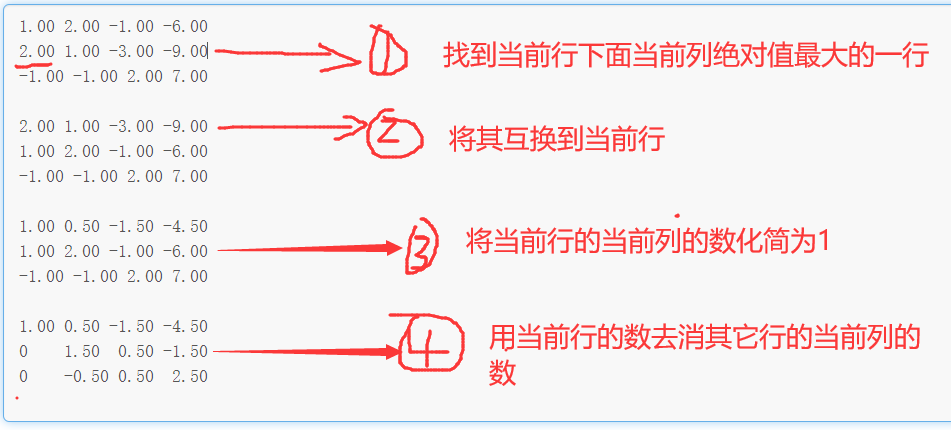
Note: here is the first row and the first column at the beginning. By analogy, it will be reduced to a stepped determinant.
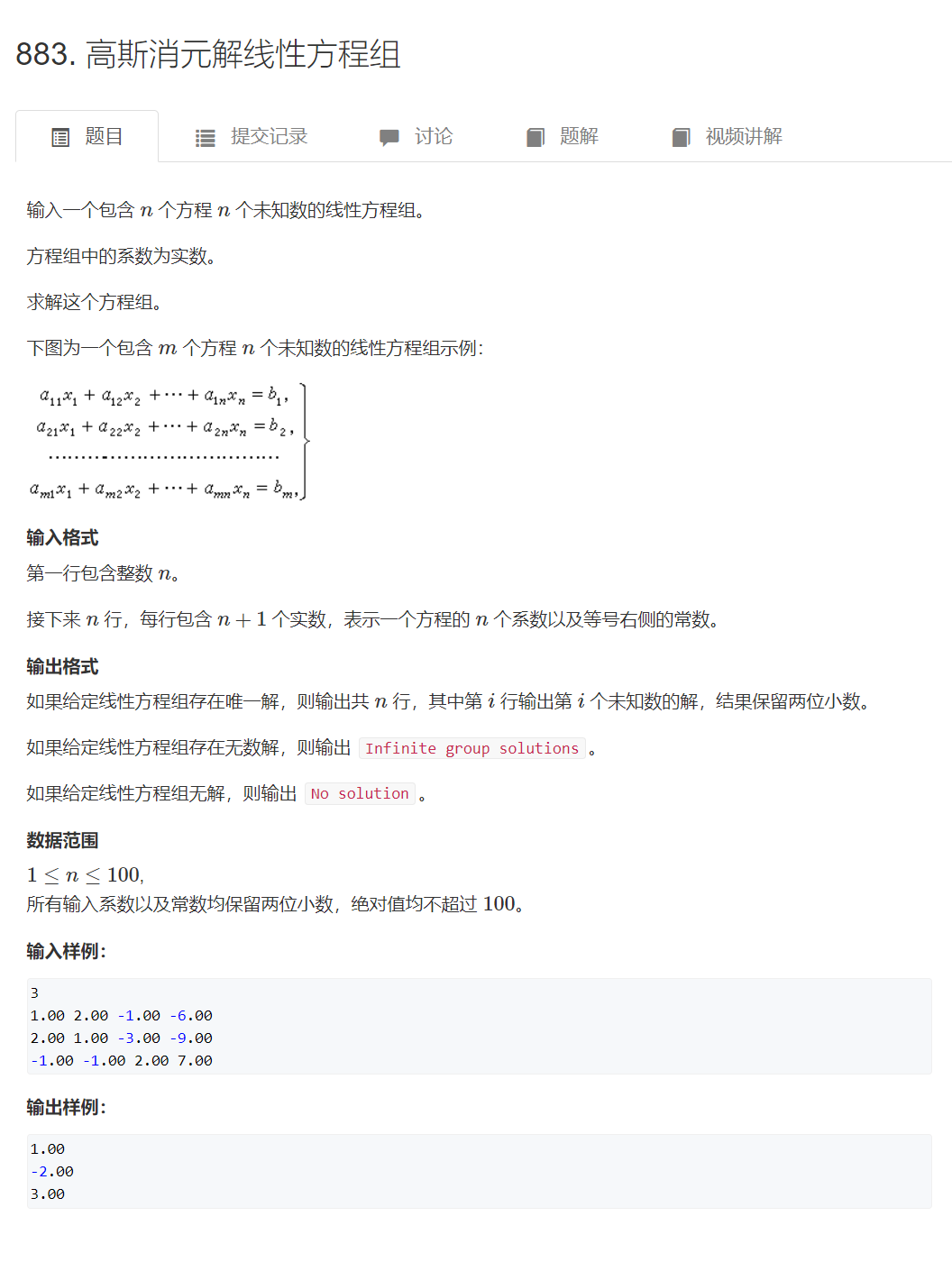
https://www.acwing.com/problem/content/description/885/
The simulated code according to the above steps is as follows:
#include<cstdio>
#include<iostream>
#include<algorithm>
#include<cmath>
using namespace std;
const int N=110;
const double eps=1e-6;
double a[N][N];
int n;
void print()
{
for(int i=1;i<=n;i++)
{
for(int j=1;j<=n+1;j++)
cout<<a[i][j]<<" ";
cout<<endl;
}
cout<<endl;
}
int gauss()
{
int c,r;
for(c=1,r=1;c<=n;c++)
{
int t=r;
for(int i=r;i<=n;i++)//1 Search
{
if(fabs(a[i][c])>fabs(a[t][c])) t=i;
}
if(fabs(a[t][c])<eps) continue;
for(int i=c;i<=n+1;i++) swap(a[r][i],a[t][i]);//2 exchange
for(int i=n+1;i>=c;i--) a[r][i]=a[r][i]/a[r][c];//3 simplification
for(int i=r+1;i<=n;i++)//Clear the column below the row
{
if (fabs(a[i][c]) > eps)//If the current column is not 0, you don't need to clear it if it is 0.
for(int j=n+1;j>=c;j--)
{
a[i][j]-=a[i][c]*a[r][j];
}
}
r++;
}
if (r <= n)//It means that our lines r to n are all zeros.
{
for (int i = r; i <= n; i ++ )//If the constant term is not zero, there will be a contradiction of 0 = 3
if (fabs(a[i][n+1]) > eps)
return 2;//unsolvable
return 1;
}
for (int i = n; i >1 0; i -- )//Reverse solution
for (int j = i + 1; j <= n; j ++ )
a[i][n+1] -= a[j][n+1] * a[i][j];
return 0;
}
int main(void)
{
cin>>n;
for(int i=1;i<=n;i++)
{
for(int j=1;j<=n+1;j++)
cin>>a[i][j];
}
int t=gauss();
if (t == 0)
{
for (int i = 1; i <= n; i ++ ) printf("%.2lf\n", a[i][n+1]);
}
else if (t == 1) puts("Infinite group solutions");
else puts("No solution");
return 0;
}
Here are some common questions you don't understand:
Question 1: why should the operation simplified to 1 and the clearing operation be pushed backwards.
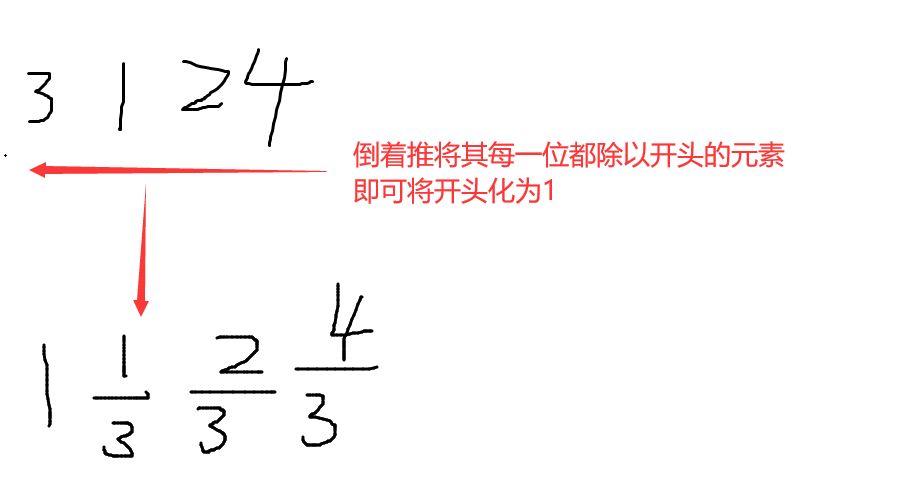
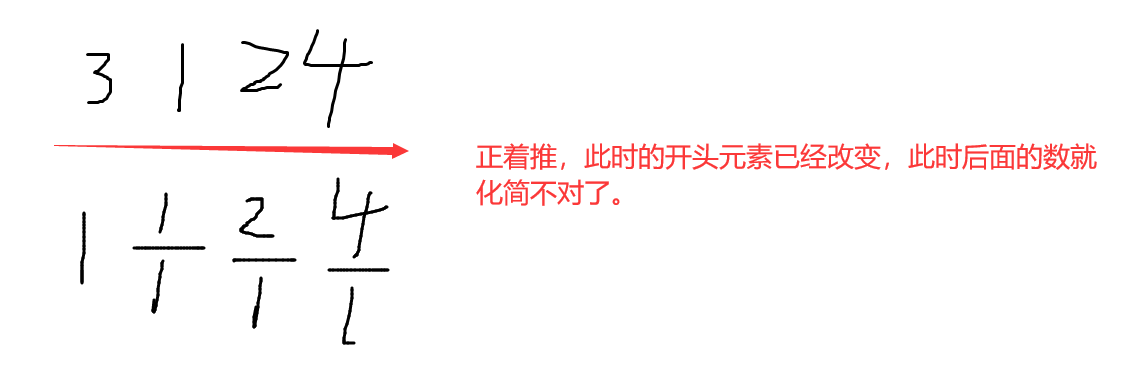
Of course, you can also push forward, but you need to use a variable to record the value of the first element. Just divide the simplification by this value.
But it's a little troublesome.
Then the code is as follows:
#include<cstdio>
#include<iostream>
#include<algorithm>
#include<cmath>
using namespace std;
const int N=110;
const double eps=1e-6;
double a[N][N];
int n;
void print()
{
for(int i=1;i<=n;i++)
{
for(int j=1;j<=n+1;j++)
cout<<a[i][j]<<" ";
cout<<endl;
}
cout<<endl;
}
int gauss()
{
int c,r;
for(c=1,r=1;c<=n;c++)
{
int t=r;
for(int i=r;i<=n;i++)//1 Search
{
if(fabs(a[i][c])>fabs(a[t][c])) t=i;
}
if(fabs(a[t][c])<eps) continue;
for(int i=c;i<=n+1;i++) swap(a[r][i],a[t][i]);//2 exchange
double x=a[r][c];
for(int i=c;i<=n+1;i++) a[r][i]=a[r][i]/x;//3 simplification
for(int i=r+1;i<=n;i++)
{
if (fabs(a[i][c]) > eps)
{
double x=a[i][c];
for(int j=c;j<=n+1;j++)
{
a[i][j]-=x*a[r][j];
}
}
}
r++;
}
if (r <= n)
{
for (int i = r; i <= n; i ++ )
if (fabs(a[i][n+1]) > eps)
return 2;
return 1;
}
for (int i = n; i >= 1; i -- )
for (int j = i + 1; j <= n; j ++ )
a[i][n+1] -= a[j][n+1] * a[i][j];
return 0;
}
int main(void)
{
cin>>n;
for(int i=1;i<=n;i++)
{
for(int j=1;j<=n+1;j++)
cin>>a[i][j];
}
int t=gauss();
if (t == 0)
{
for (int i = 1; i <= n; i ++ ) printf("%.2lf\n", a[i][n+1]);
}
else if (t == 1) puts("Infinite group solutions");
else puts("No solution");
return 0;
}
Question 2: if (Fabs (a [t] [C]) < EPS) continue; How to understand.
Suppose c represents a column and r represents a row. At this time, we proceed to c = 2 and r = 2
1 0 2 3
0 0 3 2
0 0 2 3
You will find that the maximum absolute value of column c under row r is 0
Explain that column c has been simplified at this time, so we don't need to carry out the following simplification operations,
But at this time, our row r does not need to change. At this time, c plus 1, then we will start from the second row and the third column to find the number with the largest absolute value.
If our r moves backward, then our second line is not simplified at this time, which is obviously wrong.
Taking this as an example, if R moves backward, then r = 3 and C = 3, but at this time, the third number in our second line is 3, which is not the simplest form of 1.
Question 3: how does the inverse solution come from

When there is a unique solution, our final simplification must be this.
The final form of the solution is as follows:
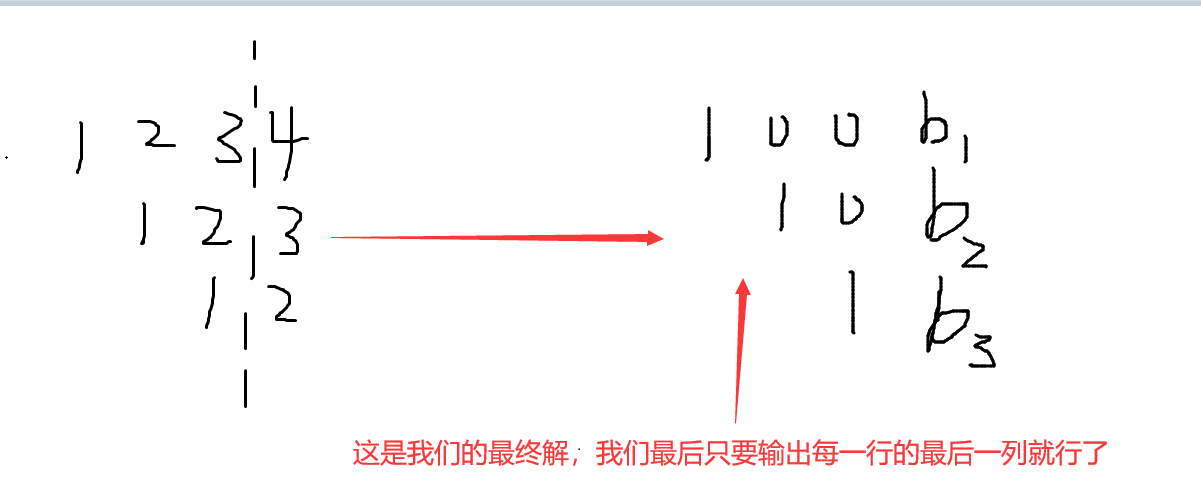
Instead, we simplify each line into the form of only one 1 for each line. Here simulation, the code will understand. I won't repeat it here.
Finally, thank you for watching. See you next time!!!